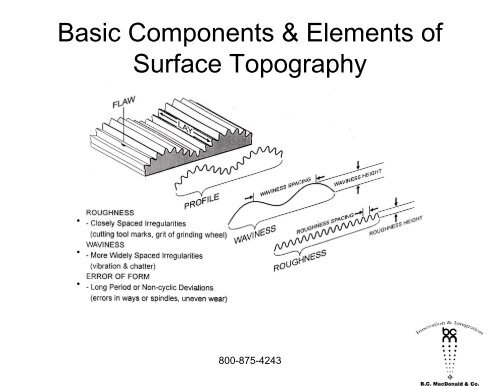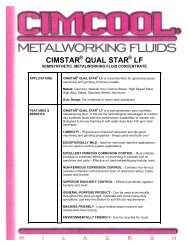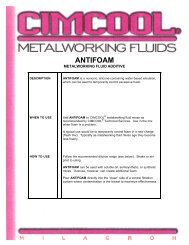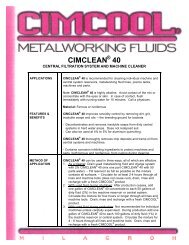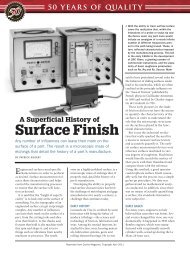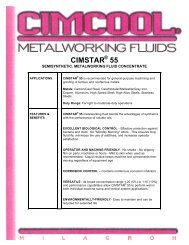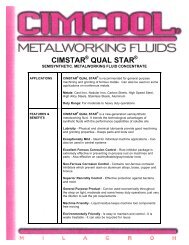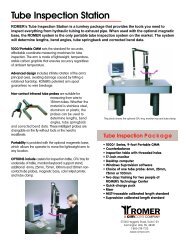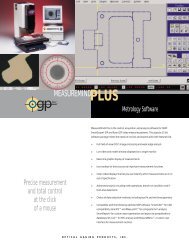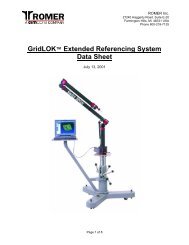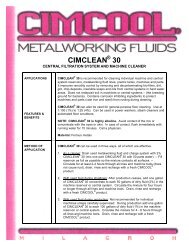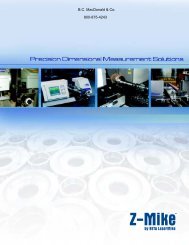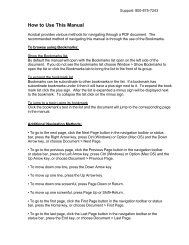Basic Components & Elements of Surface Topography
Basic Components & Elements of Surface Topography
Basic Components & Elements of Surface Topography
You also want an ePaper? Increase the reach of your titles
YUMPU automatically turns print PDFs into web optimized ePapers that Google loves.
<strong>Basic</strong> <strong>Components</strong> & <strong>Elements</strong> <strong>of</strong><br />
<strong>Surface</strong> <strong>Topography</strong><br />
•<br />
•<br />
•<br />
800-875-4243
Skid and Skidless<br />
Measuring Equipment<br />
800-875-4243
<strong>Surface</strong> Pr<strong>of</strong>ile Measurement Lengths<br />
• Sampling Length (l)<br />
• Assessment (Evaluation) Length (L)<br />
• Traversing Length<br />
800-875-4243
Cut<strong>of</strong>f Selection Effect on<br />
<strong>Surface</strong> Finish Measurement<br />
800-875-4243
Recommended Cut<strong>of</strong>fs for Different<br />
<strong>Surface</strong> Finishes<br />
800-875-4243
Traditional <strong>Surface</strong> Texture<br />
Parameters and Functions<br />
•<br />
•<br />
•<br />
•<br />
Some <strong>of</strong> these parameters can also be calculated from unfiltered and waviness<br />
pr<strong>of</strong>iles. (P and W families <strong>of</strong> parameters)<br />
800-875-4243
R a = AA = CLA<br />
R q = RMS<br />
On majority <strong>of</strong> prints only R a is specified.<br />
800-875-4243
Roughness Average R a<br />
800-875-4243
R a – Roughness Average<br />
Advantages<br />
• The most commonly used parameter to monitor a production process.<br />
• Default parameter on a drawing if not otherwise specified.<br />
• Available even in the least sophisticated instruments.<br />
• Statistically a very stable, repeatable parameter.<br />
• Good for random type surfaces, such as grinding.<br />
• A good parameter where a process is under control and where the<br />
conditions are always the same, e.g. cutting tips, speeds, feeds, cutting fluid<br />
(lubricant).<br />
Disadvantages<br />
• Not a good discriminator for different types <strong>of</strong> surfaces (no distinction is<br />
made between peaks and valleys).<br />
• Not very informative on surfaces with R sk outside ±2.<br />
• Not a good measure <strong>of</strong> sealed surfaces.<br />
800-875-4243
Ra, Rq Parameters<br />
• Roughness average R a is the arithmetic average <strong>of</strong> the<br />
absolute values <strong>of</strong> the roughness pr<strong>of</strong>ile ordinates.<br />
• Root mean square (RMS) roughness R q is the root mean<br />
square average <strong>of</strong> the roughness pr<strong>of</strong>ile ordinates.<br />
800-875-4243
R q – Root Mean Roughness<br />
R q is more sensitive to peaks and valleys then<br />
R a , because the amplitudes are squared.<br />
Applications<br />
• Very similar to R a , which practically replaced it<br />
for general use.<br />
• Used to control very fine surfaces in scientific<br />
measurements and statistical evaluations.<br />
800-875-4243
R z , R max Parameter<br />
800-875-4243
R z – Mean Peak-to-Valley Height<br />
R max – Maximum Peak-to-Valley Height<br />
Applications<br />
• R z is more sensitive than Ra to changes in surface finish as<br />
maximum pr<strong>of</strong>ile heights and not averages are being examined.<br />
• R max is useful for surfaces where a single defect is not<br />
permissible, e.g. a seal with a single scratch.<br />
• R z and R max are used together to monitor the variations <strong>of</strong> surface<br />
finish in a production process. Similar values <strong>of</strong> R z and R max<br />
indicate a consistent surface finish, while a significant difference<br />
indicates a surface defect in an otherwise consistent surface.<br />
800-875-4243
R p , R pm Parameter<br />
• The Mean Leveling Depth R pm is the mean <strong>of</strong> five leveling depths <strong>of</strong> five<br />
successive sample lengths l.<br />
R pm = 1/5 (R p1 + R p2 + R p3 + R p4 + R p5 )<br />
• The Leveling Depth R p is also the largest <strong>of</strong> the five leveling depths. The<br />
Maximum Roughness Depth R t (peak to valley height) is the vertical distance<br />
between the highest peak and the lowest valley <strong>of</strong> the roughness pr<strong>of</strong>ile R<br />
within the evaluation length L.<br />
800-875-4243
R p and R pm<br />
• R p , per ISO 4287, is the max height <strong>of</strong> any peak to the mean line within one<br />
sampling length.<br />
• R pm , the mean leveling depth - per rules <strong>of</strong> ISO 4288, is an averaging <strong>of</strong> R p over<br />
5 cut<strong>of</strong>fs; according to ASME B46.1-2002, R p calculated over the evaluation<br />
length is R pm .<br />
• Many instruments, e.g., M2 Series, measure R pm but report the result as R p .<br />
Applications<br />
• R pm is useful in predicting bearing characteristics <strong>of</strong> a surface.<br />
• A low value <strong>of</strong> R pm and large value <strong>of</strong> R z indicates a plateau surface<br />
• The ratio R pm /R z quantifies the asymmetry <strong>of</strong> pr<strong>of</strong>ile.<br />
• R pm is recommended for bearing and sliding surfaces and surface substrates<br />
prior to coating.<br />
• R v is a good parameter where stress is a major factor.<br />
• R p is a good parameter to control coating quality.<br />
800-875-4243
R 3Z , R 3zmax Parameters<br />
Per Daimler Benz Corporate Standard<br />
N31007:1983<br />
• R 3z<br />
– mean third highest peak-to-valley height over 5 sampling length.<br />
• R 3zmax<br />
– maximum third highest peak-to-valley height <strong>of</strong> the 5 third highest<br />
peak-to-valley height.<br />
R 3z<br />
disregards the 2 highest peaks and deepest valleys that have little effect on the<br />
surface performance, with the intent to reduce the instability <strong>of</strong> peak parameters<br />
(such as R z<br />
), by ignoring pr<strong>of</strong>ile extremes.<br />
Applications<br />
Sealing <strong>Surface</strong>s<br />
Porous <strong>Surface</strong>s<br />
800-875-4243
Bearing Length Ratio t p (R mr )<br />
800-875-4243
Bearing Area Curve (BAC)<br />
800-875-4243
Different Methods <strong>of</strong> t p (R mr )<br />
BAC Evaluation<br />
Applications<br />
• Probable run-in behavior and wear resistance<br />
<strong>of</strong> surfaces such as sliding and rolling faces<br />
(e.g., cylinder liners).<br />
• Seals, bearings, electrical and thermal<br />
controls, adhesives, coatings, etc.<br />
800-875-4243
Pc (RPc) – Peak Count<br />
Nr – Normalized Peak Count<br />
The peak count is the number <strong>of</strong> local roughness peaks which<br />
project through a selectable band centered about the mean<br />
line. The count is determined over the evaluation length and<br />
is reported in peaks per cm or inch.<br />
HSC (RHSC) – High Spot Count<br />
The number <strong>of</strong> roughness peaks, reported in peaks per cm,<br />
projecting through the mean line, or a line parallel to it, at a<br />
selected distance above or below the mean line.<br />
800-875-4243
Pc (RPc), Nr<br />
HSC (RHSC)<br />
Applications<br />
• Sheet metal industry to measure quality <strong>of</strong><br />
surfaces subjected to bending, forming and<br />
painting and where appearance is critical.<br />
• General adhesion and coating applications.<br />
800-875-4243
R k Family <strong>of</strong> Parameters<br />
A 1<br />
A 2<br />
R k<br />
R pk<br />
R vk<br />
M r1<br />
M r2<br />
R pkx (R pk *)<br />
R vkx (R vk *)<br />
Material filled pr<strong>of</strong>ile peak area<br />
Lubricant filled pr<strong>of</strong>ile valley area<br />
Core roughness depth<br />
Reduced peak height<br />
Reduced valley depth<br />
Material component relative to peaks<br />
Material component relative to valleys<br />
Total Peak Height<br />
Total Valley Depth<br />
Applications<br />
– Multiprocessed, multipurpose surfaces, such as<br />
plateau honed<br />
– Sintered, porous surfaces<br />
800-875-4243
Waviness Height - W t<br />
Sum <strong>of</strong> the largest peak height and the largest valley depth <strong>of</strong><br />
waviness pr<strong>of</strong>ile within evaluation length L<br />
Applications<br />
– To monitor processes where in addition to roughness, waviness, possibly<br />
caused by vibrations (both within the machine and external), is also critical.<br />
– e.g. – cylinder head waviness <strong>of</strong> the sealing surface produced on a vertical<br />
mill largely depends on the alignment <strong>of</strong> the cutting tips in the milling head.<br />
800-875-4243
Corresponding<br />
Parameters in<br />
Parameters Defined in ASME B46.1-2002 ISO 4287-1997<br />
R a Arithmetic Average Deviation <strong>of</strong> the Assessed Pr<strong>of</strong>ile R a<br />
R q Root Mean Square Deviation <strong>of</strong> the Assessed Pr<strong>of</strong>ile R q<br />
R p Maximum Pr<strong>of</strong>ile Peak Height R p<br />
R v Maximum Pr<strong>of</strong>ile Valley Depth R v<br />
R t Maximum Height <strong>of</strong> the Pr<strong>of</strong>ile R t<br />
R pm Average Maximum Pr<strong>of</strong>ile Peak Height ----<br />
R z Average Maximum Height <strong>of</strong> the Pr<strong>of</strong>ile R y<br />
R max Maximum Roughness Depth ----<br />
S m Mean Spacing <strong>of</strong> Pr<strong>of</strong>ile Irregularities R sm<br />
P c Peak Density ----<br />
800-875-4243
Corresponding<br />
Parameters in<br />
Parameters Defined in ASME B46.1-2002 ISO 4287-1997<br />
t p Pr<strong>of</strong>ile Bearing Ratio R mr(c)<br />
H tp Difference in the Heights for Two t p Ratios R δc<br />
R sk Skewness R sk<br />
W t Waviness Height W t<br />
R ku Kurtosis R ku<br />
∆ a Average Absolute Slope ----<br />
∆ q Root Mean Square Slope R dq<br />
800-875-4243
ISO Standards on <strong>Surface</strong> Finish<br />
ISO 1302 - 2001<br />
ISO 3274 - 1996<br />
ISO 4287 - 1997<br />
ISO 4288 - 1996<br />
ISO 5436-1 - 2000<br />
ISO 5436-2 - 2000<br />
ISO 8785 - 1999<br />
ISO 11562 - 1996<br />
ISO 12085 - 1996<br />
ISO 12179 - 2000<br />
ISO 13565 - 1996<br />
Part 1<br />
Part 2<br />
Part 3<br />
Indication <strong>of</strong> <strong>Surface</strong> Texture<br />
Nominal Characteristics <strong>of</strong> Contact (Stylus) Instruments<br />
Terms, Definition and <strong>Surface</strong> Texture Parameters<br />
Rules and Procedures for Assessment <strong>of</strong> <strong>Surface</strong> Texture<br />
Calibration, Measurement Standards<br />
Calibration, S<strong>of</strong>t Gages<br />
<strong>Surface</strong> Imperfections - Terms, Definitions and Parameters<br />
Metrological Characteristics <strong>of</strong> Phase Correct Filters<br />
Motif Parameters<br />
Calibration <strong>of</strong> Contact (Stylus) Instruments<br />
Characterization <strong>of</strong> <strong>Surface</strong>s Having Stratified Functional<br />
Properties<br />
Filtering and General Measurement Conditions<br />
Height Characterization using the Linear Ratio Curve Conditions<br />
Height Characterization using the Material Probability Curve <strong>of</strong><br />
<strong>Surface</strong>s Consisting <strong>of</strong> Two Vertical Random <strong>Components</strong><br />
800-875-4243
R z to R a Conversion<br />
• BS 1134/1-1972<br />
• Siemens Recommendations<br />
R z = x4 - x7 R a<br />
R z = x4 - x10 R a<br />
– Actual ratio depends upon the shape <strong>of</strong> the pr<strong>of</strong>ile.<br />
800-875-4243
<strong>Surface</strong> Texture Symbols<br />
ASME Y14.36M-1996 ISO 1302-1992 ISO 1302-2000<br />
b<br />
c<br />
a<br />
x<br />
c f<br />
a<br />
b<br />
e d<br />
e d<br />
a = roughness value Ra a = one single parameter and sampling<br />
b = production method, treatment, length or cut<strong>of</strong>f<br />
coating, other text, or note callout b = other parameters<br />
c = roughness cut<strong>of</strong>f or sampling length c = production method, treatment,coating<br />
d = direction <strong>of</strong> lay<br />
d = direction <strong>of</strong> lay<br />
e = minimum material removal requirement e = material removal allowance<br />
f = roughness value other than Ra preceded x = not to be used<br />
by its parameter symbol (e.g. Rz 0.4) ∇= material removal symbol<br />
∇= material removal symbol<br />
800-875-4243
Different Methods <strong>of</strong> Designating R a 32<br />
Symbol<br />
Standard<br />
32 AA<br />
ANSI B46.1-1962<br />
32 CLA<br />
32 AARH<br />
RNR 0.8<br />
0.8a<br />
0.8<br />
N6<br />
CH 18<br />
0.8<br />
Ra 0.8<br />
32<br />
BS 1134-1961<br />
Rare US Designation<br />
Old US MIL Specifications<br />
JIS B0601-1976<br />
JIS B0601-1976 DIN3141-1960<br />
JIS B0601-1976<br />
ISO 1302-1978<br />
Charmilles – VDI 3400<br />
ASME Y14.36M-1996 ISO 1302-1978<br />
ISO 1302-2002<br />
Common US Designation<br />
800-875-4243
WHERE DO WE GO WRONG IN<br />
SURFACE FINISH GAGING?<br />
• Including Flaws and Defects into the Measurements<br />
• Inattention to Leveling<br />
• Not Taking Into Consideration Environmental Conditions<br />
• Not Understanding Calibration Procedures and Limitations<br />
• Ignoring Advanced Gage Functions<br />
800-875-4243


